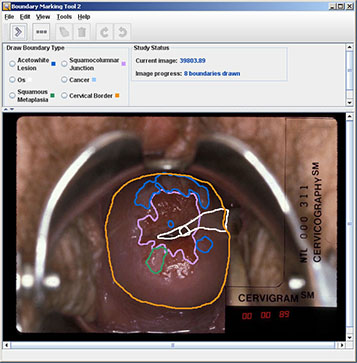Software: Boundary Marking Tool 2 (BMT2)
Neve L, Long LR, Antani SK
Abstract:
 Overview. The Boundary Marking Tool 2 (BMT2) was developed by the National Library of Medicine in collaboration with the National Cancer Institute. The BMT2 is software that allows the manual marking of boundaries on digitized images and the recording of diagnostic or interpretive data that applies to these individual boundaries, or to the image as a whole. It has been used in multiple studies by NCI of the correlation between visual observations of the cervix and biopsy-based diagnoses. It has been used in the NCI Biopsy Study, which aims to determine whether taking multiple biopsies at colposcopy will increase the detectability of high-grade cervix disease, and to develop a strategy for taking these biopsies. In 2014 van der Marel [1] recommended that taking multiple biopsies should become standard practice in colposcopy, following the study of data collected, using the BMT, for 610 patients in the Netherlands and Spain. In 2015 Wentzensen [2] reported on the results of analyzing data collected, using the BMT, from 690 patients at the University of Oklahoma, and made the same recommendation. In addition, in 2014, the BMT was used by the American Society for Colposcopy and Cervical Pathology (ASCCP) to mark up and review biopsy regions on cervix images for use in creating materials for proficiency exams in the field of colposcopy. The impact of the Boundary Marking Tool in biomedical research, as well as the impact of other software tools developed in the National Library of Medicine/National Cancer Institute collaboration, is summarized here.
Overview. The Boundary Marking Tool 2 (BMT2) was developed by the National Library of Medicine in collaboration with the National Cancer Institute. The BMT2 is software that allows the manual marking of boundaries on digitized images and the recording of diagnostic or interpretive data that applies to these individual boundaries, or to the image as a whole. It has been used in multiple studies by NCI of the correlation between visual observations of the cervix and biopsy-based diagnoses. It has been used in the NCI Biopsy Study, which aims to determine whether taking multiple biopsies at colposcopy will increase the detectability of high-grade cervix disease, and to develop a strategy for taking these biopsies. In 2014 van der Marel [1] recommended that taking multiple biopsies should become standard practice in colposcopy, following the study of data collected, using the BMT, for 610 patients in the Netherlands and Spain. In 2015 Wentzensen [2] reported on the results of analyzing data collected, using the BMT, from 690 patients at the University of Oklahoma, and made the same recommendation. In addition, in 2014, the BMT was used by the American Society for Colposcopy and Cervical Pathology (ASCCP) to mark up and review biopsy regions on cervix images for use in creating materials for proficiency exams in the field of colposcopy. The impact of the Boundary Marking Tool in biomedical research, as well as the impact of other software tools developed in the National Library of Medicine/National Cancer Institute collaboration, is summarized here.
We provide two alternative ways to use the BMT2.
First way (Download and Install Software): Download the Bundled BMT2 (NCI Biopsy Study BMT2); this is a Microsoft Windows setup file which installs the BMT2 and all required software on your computer (namely MySQL, Tomcat and Java if necessary), and asks you to agree to a license regarding its proper use and redistribution. This is the way that the National Cancer Institute is currently using the BMT2 to mark images acquired from digital cameras, and to store the marked images locally, without requiring an Internet connection. This approach offers a bundled installation which gets you up and running quickly without requiring anything additional.Download the Bundled BMT2 (NCI Biopsy Study BMT2) setup file here (https://ceb.nlm.nih.gov/imsbmt/bmt_setup.exe). Then follow these installation instructions.
Second way (Web Interface): Run the BMT2 directly from our NLM Communications Engineering Branch website with a user account that we can provide. This approach allows you to run the BMT2 on any type of computer (Mac, Linux, etc.) with Oracle's Java 1.5 or greater installed. Request a BMT2 account here (https://www.nlm.nih.gov/research/researchstaff/AntaniSameer.html). Then launch the BMT2.
-
Van der Marel J, Schiffman M, Wentzensen N, et al. The increased detection of cervical intraepithelial neoplasia when using a second biopsy at colposcopy. Gynecologic Oncology, Nov. 2014, 135(2):201-7.
-
Wentzensen N, Zuna RE, Schiffman M, et al. Multiple biopsies and detection of cervical cancer precursors at colposcopy. Journal of Clinical Oncology, Jan. 2015, 33(1):83-9.
Neve L, Long LR, Antani SK. Software: Boundary Marking Tool 2 (BMT2)


